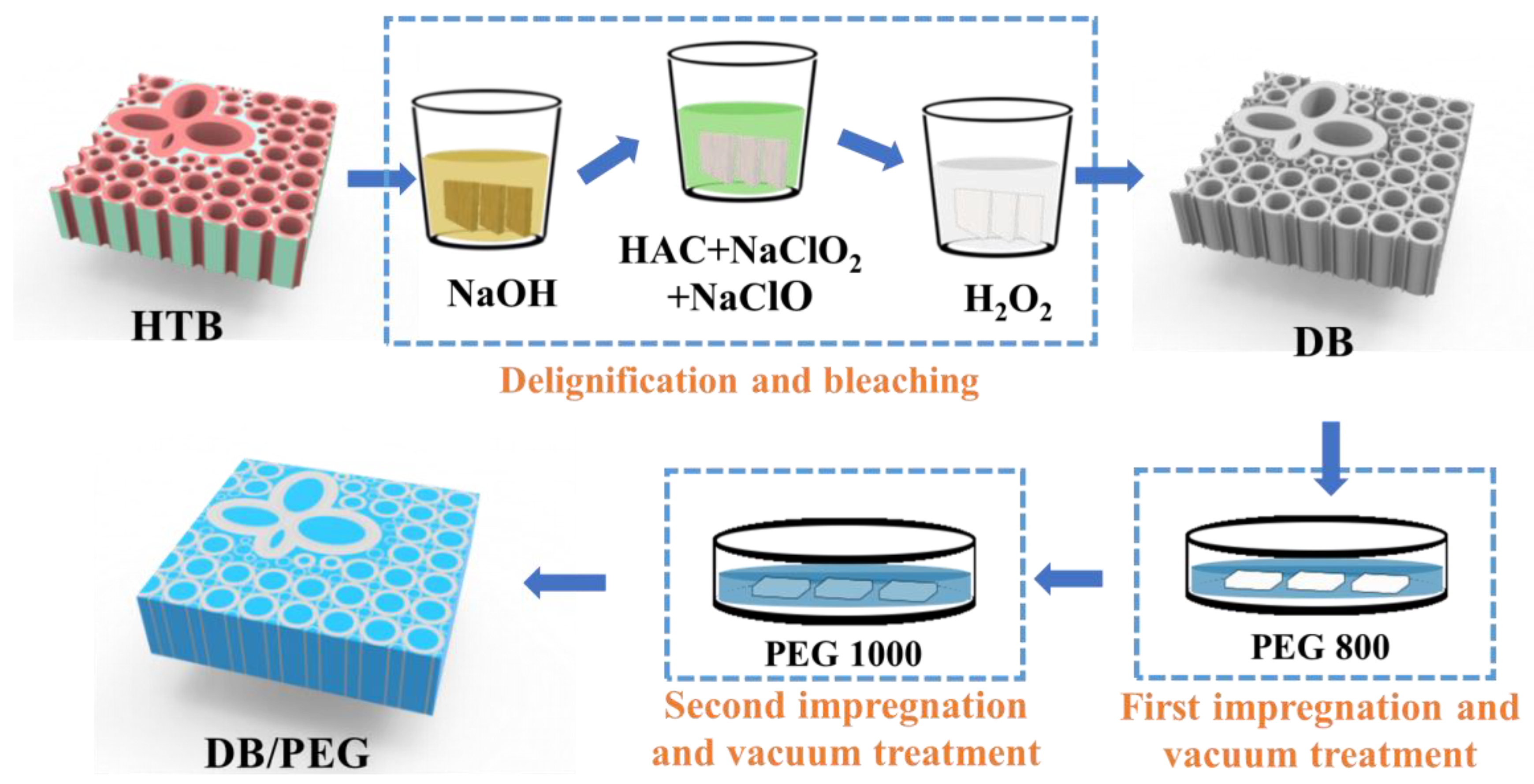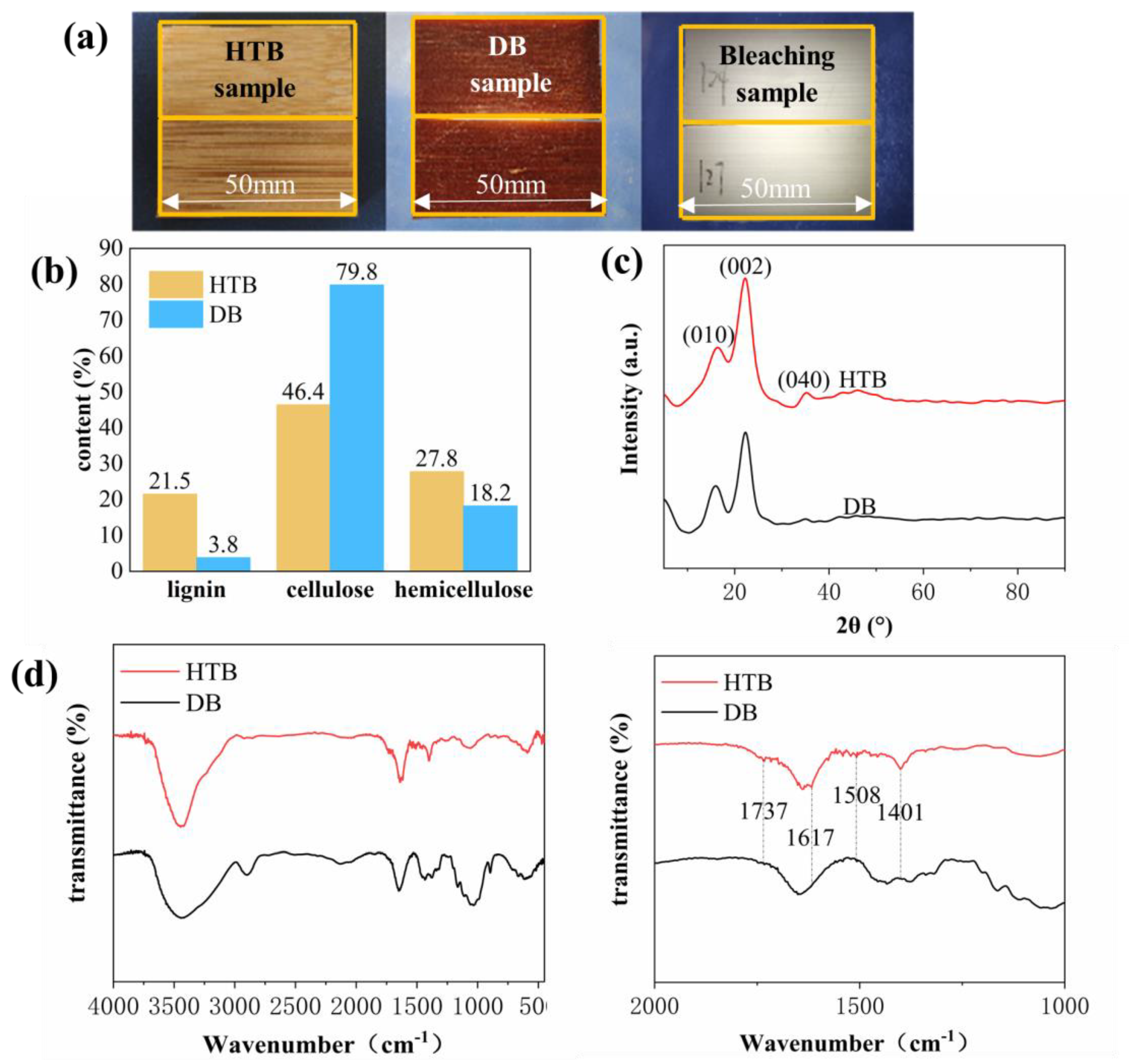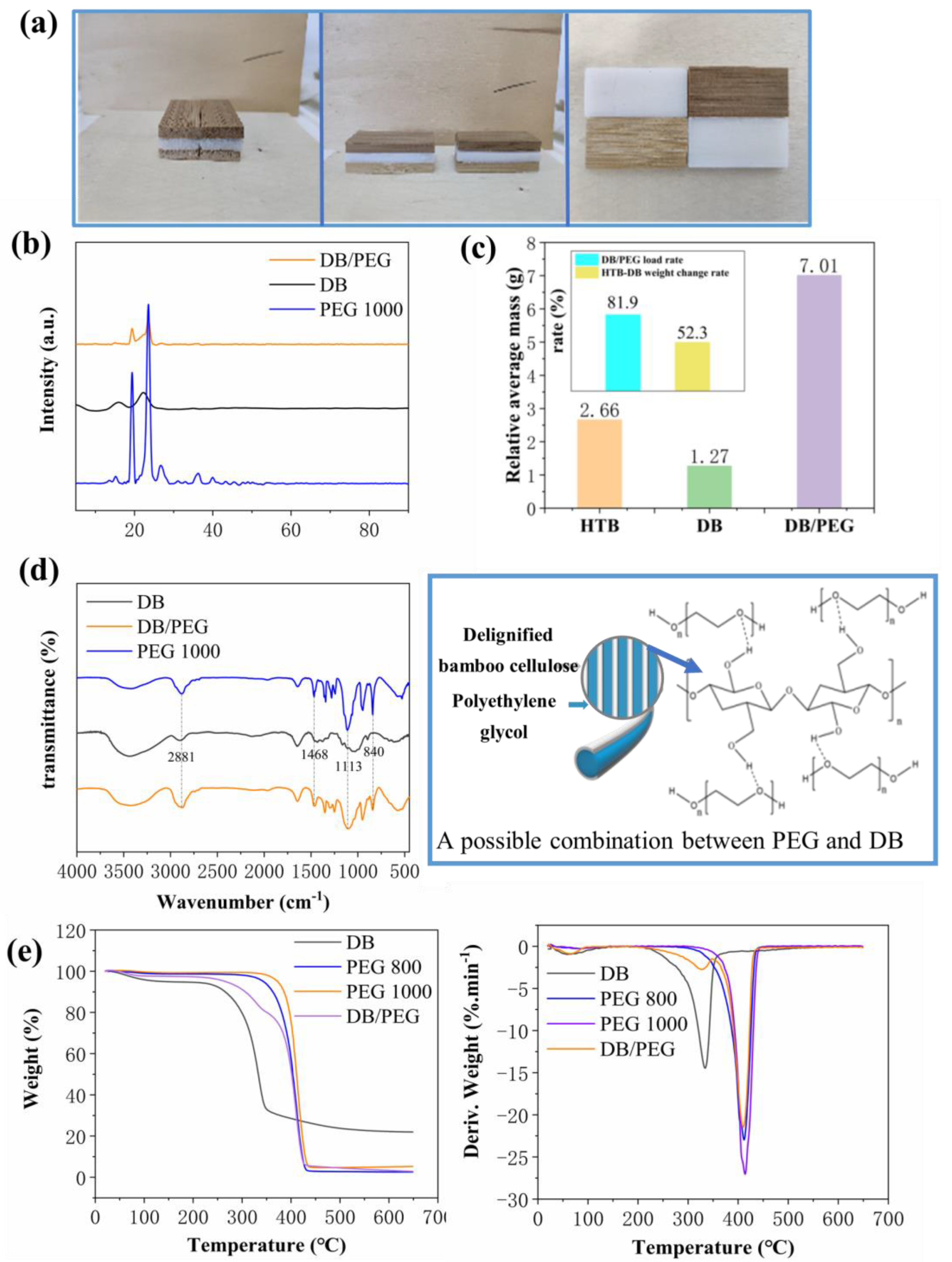Dimensionally Stable Delignified Bamboo Matrix Phase-Change Composite under Ambient Temperature for Indoor Thermal Regulation
Abstract
1. Introduction
2. Materials and Methods
2.1. Materials
2.2. Delignification and Bleaching of Bamboo Samples
2.3. Preparation of Bamboo Cellulose Matrix Phase-Change Composite
2.4. Characterization
2.4.1. Lignin Content Testing
2.4.2. Cellulose and Hemicellulose Content Testing
2.4.3. Scanning Electron Microscopy (SEM)
2.4.4. X-ray Diffractometer (XRD)
2.4.5. Fourier Transform Infrared Spectrometer (FT-IR)
2.4.6. Differential Scanning Calorimeter (DSC)
2.4.7. Thermogravimetric Analyzer (TGA)
2.4.8. Dimensions and Quality Recording
2.4.9. Infrared Thermal Imager (IR Imager)
2.4.10. The Thermal Stability of DB/PEG Composite
3. Results and Discussion
4. Conclusions
Author Contributions
Funding
Institutional Review Board Statement
Data Availability Statement
Acknowledgments
Conflicts of Interest
References
- Stropnik, R.; Koželj, R.; Zavrl, E.; Stritih, U. Improved thermal energy storage for nearly zero energy buildings with PCM integration. Sol. Energy 2019, 190, 420–426. [Google Scholar] [CrossRef]
- Kishore, R.A.; Bianchi, M.V.A.; Booten, C.; Vidal, J.; Jackson, R. Optimizing PCM-integrated walls for potential energy savings in U.S. Buildings. Energy Build. 2020, 226, 110355. [Google Scholar] [CrossRef]
- Mehling, H.; Brütting, M.; Haussmann, T. PCM products and their fields of application—An overview of the state in 2020/2021. J. Energy Storage 2022, 51, 104354. [Google Scholar] [CrossRef]
- Pielichowska, K.; Pielichowski, K. Phase change materials for thermal energy storage. Prog. Mater. Sci. 2014, 65, 67–123. [Google Scholar] [CrossRef]
- Nazir, H.; Batool, M.; Osorio, F.J.B.; Isaza-Ruiz, M.; Xu, X.; Vignarooban, K.; Phelan, P.; Kannan, A.M. Recent developments in phase change materials for energy storage applications: A review. Int. J. Heat Mass Tran. 2019, 129, 491–523. [Google Scholar] [CrossRef]
- Mohamed, S.A.; Al-Sulaiman, F.A.; Ibrahim, N.I.; Zahir, H.; Al-Ahmed, A.; Saidur, R.; Yılbaş, B.S.; Sahin, A.Z. A review on current status and challenges of inorganic phase change materials for thermal energy storage systems. Renew. Sustain. Energy Rev. 2017, 70, 1072–1089. [Google Scholar] [CrossRef]
- Shen, Z.; Kwon, S.; Lee, H.L.; Toivakka, M.; Oh, K. Cellulose nanofibril/carbon nanotube composite foam-stabilized paraffin phase change material for thermal energy storage and conversion. Carbohydr. Polym. 2021, 273, 118585. [Google Scholar] [CrossRef]
- Mohamed Moussa, E.I.; Karkri, M. A numerical investigation of the effects of metal foam characteristics and heating/cooling conditions on the phase change kinetic of phase change materials embedded in metal foam. J. Energy Storage 2019, 26, 100985. [Google Scholar] [CrossRef]
- Tang, L.; Zhao, X.; Feng, C.; Bai, L.; Yang, J.; Bao, R.; Liu, Z.; Yang, M.; Yang, W. Bacterial cellulose/MXene hybrid aerogels for photodriven shape-stabilized composite phase change materials. Sol. Energy Mater. Sol. Cells 2019, 203, 110174. [Google Scholar] [CrossRef]
- Yang, H.; Liu, Y.; Li, J.; Wang, C.; Li, Y. Full-wood photoluminescent and photothermic materials for thermal energy storage. Chem. Eng. J. 2021, 403, 126406. [Google Scholar] [CrossRef]
- Yang, H.; Chao, W.; Wang, S.; Yu, Q.; Cao, G.; Yang, T.; Liu, F.; Di, X.; Li, J.; Wang, C.; et al. Self-luminous wood composite for both thermal and light energy storage. Energy Storage Mater. 2019, 18, 15–22. [Google Scholar] [CrossRef]
- Yang, H.; Chao, W.; Di, X.; Yang, Z.; Yang, T.; Yu, Q.; Liu, F.; Li, J.; Li, G.; Wang, C. Multifunctional wood based composite phase change materials for magnetic-thermal and solar-thermal energy conversion and storage. Energy Convers. Manag. 2019, 200, 112029. [Google Scholar] [CrossRef]
- Yang, H.; Wang, S.; Wang, X.; Chao, W.; Wang, N.; Ding, X.; Liu, F.; Yu, Q.; Yang, T.; Yang, Z.; et al. Wood-based composite phase change materials with self-cleaning superhydrophobic surface for thermal energy storage. Appl. Energy 2020, 261, 114481. [Google Scholar] [CrossRef]
- Yang, H.; Wang, Y.; Yu, Q.; Cao, G.; Yang, R.; Ke, J.; Di, X.; Liu, F.; Zhang, W.; Wang, C. Composite phase change materials with good reversible thermochromic ability in delignified wood substrate for thermal energy storage. Appl. Energy 2018, 212, 455–464. [Google Scholar] [CrossRef]
- Wang, X.; Shan, S.; Shi, S.Q.; Zhang, Y.; Cai, L.; Smith, L.M. Optically Transparent Bamboo with High Strength and Low Thermal Conductivity. ACS Appl. Mater. Inter. 2021, 13, 1662–1669. [Google Scholar] [CrossRef]
- Wu, Y.; Wang, J.; Wang, Y.; Zhou, J. Properties of Multilayer Transparent Bamboo Materials. ACS Omega 2021, 6, 33747–33756. [Google Scholar] [CrossRef]
- Heng, Y.; Feng, N.; Liang, Y.; Hu, D. Lignin-retaining porous bamboo-based reversible thermochromic phase change energy storage composite material. Int. J. Energy Res. 2020, 44, 5441–5454. [Google Scholar] [CrossRef]
- Kalali, E.N.; Hu, Y.; Wang, X.; Song, L.; Xing, W. Highly-aligned cellulose fibers reinforced epoxy composites derived from bulk natural bamboo. Ind. Crop. Prod. 2019, 129, 434–439. [Google Scholar] [CrossRef]
- Kou, Y.; Wang, S.; Luo, J.; Sun, K.; Zhang, J.; Tan, Z.; Shi, Q. Thermal analysis and heat capacity study of polyethylene glycol (PEG) phase change materials for thermal energy storage applications. J. Chem. Thermodyn. 2019, 128, 259–274. [Google Scholar] [CrossRef]
- Ibrahim, N.I.; Al-Sulaiman, F.A.; Rahman, S.; Yilbas, B.S.; Sahin, A.Z. Heat transfer enhancement of phase change materials for thermal energy storage applications: A critical review. Renew. Sustain. Energy Rev. 2017, 74, 26–50. [Google Scholar] [CrossRef]
- Li, M.-F.; Shen, Y.; Sun, J.-K.; Bian, J.; Chen, C.-Z.; Sun, R.-C. Wet Torrefaction of Bamboo in Hydrochloric Acid Solution by Microwave Heating. ACS Sustain. Chem. Eng. 2015, 3, 2022–2029. [Google Scholar] [CrossRef]
- Wu, Y.; Wang, Y.; Yang, F.; Wang, J.; Wang, X. Study on the Properties of Transparent Bamboo Prepared by Epoxy Resin Impregnation. Polymers 2020, 12, 863. [Google Scholar] [CrossRef] [PubMed]
- Wu, Y.; Zheng, Y.; Yang, F.; Yang, L. Preparation process and characterization of mechanical properties of twisted bamboo spun fiber bundles. J. Mater. Res. Technol. 2021, 14, 2131–2139. [Google Scholar] [CrossRef]
- Feng, N.; Liang, Y.; Hu, D. Delignified bamboo as skeleton matrix for shape-stable phase change heat storage material with excellent reversible thermochromic response property. J. Energy Storage 2020, 30, 101401. [Google Scholar] [CrossRef]
- Zhou, C.; Julianri, I.; Wang, S.; Chan, S.H.; Li, M.; Long, Y. Transparent Bamboo with High Radiative Cooling Targeting Energy Savings. ACS Mater. Lett. 2021, 3, 883–888. [Google Scholar] [CrossRef]
- Meng, Y.; Zhao, Y.; Zhang, Y.; Tang, B. Induced dipole force driven PEG/PPEGMA form-stable phase change energy storage materials with high latent heat. Chem. Eng. J. 2020, 390, 124618. [Google Scholar] [CrossRef]
- Qin, Y.; Zhu, Y.; Luo, X.; Liang, S.; Wang, J.; Zhang, L. End group modification of polyethylene glycol (PEG): A novel method to mitigate the supercooling of PEG as phase change material. Int. J. Energy Res. 2019, 43, 1000–1011. [Google Scholar] [CrossRef]
- Zhang, Y.; Qin, M.; Xu, W.; Fu, Y.; Wang, Z.; Li, Z.; Willför, S.; Xu, C.; Hou, Q. Structural changes of bamboo-derived lignin in an integrated process of autohydrolysis and formic acid inducing rapid delignification. Ind. Crop. Prod. 2018, 115, 194–201. [Google Scholar] [CrossRef]
- Zhang, Y.; Zhang, X.; Yu, Y.; Che, W.; Zhang, X.; Hou, J. Evaluating the comprehensive influences of heat treatment and polydimethylsiloxane on integrated performance of bamboo timber. RSC Adv. 2020, 1, 43438–43446. [Google Scholar] [CrossRef] [PubMed]
- Yang, Z.; Deng, Y.; Li, J. Preparation of porous carbonized woods impregnated with lauric acid as shape-stable composite phase change materials. Appl. Therm. Eng. 2019, 150, 967–976. [Google Scholar] [CrossRef]
- Li, C.; Yu, H.; Song, Y.; Zhao, M. Synthesis and characterization of PEG/ZSM-5 composite phase change materials for latent heat storage. Renew. Energy 2018, 121, 45–52. [Google Scholar] [CrossRef]
- Yazdani, M.R.; Ajdary, R.; Kankkunen, A.; Rojas, O.J.; Seppälä, A. Cellulose Nanofibrils Endow Phase-Change Polyethylene Glycol with Form Control and Solid-to-gel Transition for Thermal Energy Storage. ACS Appl. Mater. Inter. 2021, 13, 6188–6200. [Google Scholar] [CrossRef]
- Shi, Z.; Xu, H.; Yang, Q.; Xiong, C.; Zhao, M.; Kobayashi, K.; Saito, T.; Isogai, A. Carboxylated nanocellulose/poly(ethylene oxide) composite films as solid–solid phase-change materials for thermal energy storage. Carbohydr. Polym. 2019, 225, 115215. [Google Scholar] [CrossRef] [PubMed]
- Ma, L.; Wang, Q.; Li, L. Delignified wood/capric acid-palmitic acid mixture stable-form phase change material for thermal storage. Sol. Energy Mater. Sol. Cells 2019, 194, 215–221. [Google Scholar] [CrossRef]
- Reid, M.S.; Villalobos, M.; Cranston, E.D. The role of hydrogen bonding in non-ionic polymer adsorption to cellulose nanocrystals and silica colloids. Curr. Opin. Colloid Interface Sci. 2017, 29, 76–82. [Google Scholar] [CrossRef]
- Kondo, T.; Sawatari, C.; Manley, R.S.J.; Gray, D.G. Characterization of hydrogen bonding in cellulose-synthetic polymer blend systems with regioselectively substituted methylcellulose. Macromolecules 1994, 27, 210–215. [Google Scholar] [CrossRef]
- Liang, X.; Yao, Y.; Xiao, X.; Liu, X.; Wang, X.; Li, Y. Pressure-Steam Heat Treatment-Enhanced Anti-Mildew Property of Arc-Shaped Bamboo Sheets. Polymers 2022, 14, 3644. [Google Scholar] [CrossRef] [PubMed]
- Ren, W.; Guo, F.; Liu, M.; Xu, H.; Wang, H.; Yu, Y. The Arrangement and Size of Cellulose Microfibril Aggregates in the Cell Walls of Sclerenchyma Fibers and Parenchyma Tissue in Bamboo. J. Renew. Mater. 2021, 9, 2291–2301. [Google Scholar] [CrossRef]
- Lian, C.; Liu, R.; Xiufang, C.; Zhang, S.; Luo, J.; Yang, S.; Liu, X.; Fei, B. Characterization of the pits in parenchyma cells of the moso bamboo [Phyllostachys edulis (Carr.) J. Houz.] culm. Holzforschung 2019, 73, 629–636. [Google Scholar] [CrossRef]
- Yu, H.; Gui, C.; Ji, Y.; Li, X.; Rao, F.; Huan, W.; Li, L. Changes in Chemical and Thermal Properties of Bamboo after Delignification Treatment. Polymers 2022, 14, 2573. [Google Scholar] [CrossRef]
- Rao, J.; Jiang, J.; Prosper, N.K.; Yang, X.; Liu, T.; Cai, W.; Wang, H.; Sun, F. Combination of polyethylene glycol impregnation and paraffin heat treatment to protect round bamboo from cracking. Roy. Soc. Open Sci. 2019, 6, 190105. [Google Scholar] [CrossRef] [PubMed]
- Fan, X.; Guan, Y.; Li, Y.; Yu, H.Y.; Marek, J.; Wang, D.; Militky, J.; Zou, Z.Y.; Yao, J. Shape-Stabilized Cellulose Nanocrystal-Based Phase-Change Materials for Energy Storage. ACS Appl. Nano Mater. 2020, 3, 1741–1748. [Google Scholar] [CrossRef]
- Gök, Ö.; Alkan, C.; Konuklu, Y. Developing a poly(ethylene glycol)/cellulose phase change reactive composite for cooling application. Sol. Energy Mater. Sol. Cells 2019, 191, 345–349. [Google Scholar] [CrossRef]





| Sample | Number | Weight (g) | Length (mm) | Width (mm) | Height (mm) | Weight Change Rate (%) | Length Change Rate (%) | Width Change Rate (%) | Height Change Rate (%) |
|---|---|---|---|---|---|---|---|---|---|
| HTB | 95 | 3.96 | 49.65 | 21.32 | 5.26 | 44.5 | 0 | 7.5 | 0.4 |
| DB/PEG | 7.13 | 49.66 | 22.91 | 5.28 | |||||
| HTB | 83 | 2.46 | 49.92 | 21.24 | 5.28 | 64.1 | 0 | 1.3 | 0 |
| DB/PEG | 6.85 | 49.89 | 21.51 | 5.28 | |||||
| HTB | 90 | 2.72 | 49.98 | 21.31 | 5.39 | 61.0 | 0.2 | 1.9 | 0.9 |
| DB/PEG | 6.98 | 50.06 | 21.71 | 5.44 | |||||
| HTB | 92 | 2.43 | 49.90 | 21.44 | 5.33 | 66.3 | 0.4 | 2.8 | 5.4 |
| DB/PEG | 7.22 | 49.71 | 21.93 | 5.64 |
| Sample | Tm1 (°C) | Tm2 (°C) | ΔHm (J/g) | Tc (°C) | ΔHc(J/g) |
|---|---|---|---|---|---|
| PEG-800 | 28.7 | N/A | 123.9 | 15.1 | 125.3 |
| PEG-1000 | 48.8 | N/A | 157.7 | 22.7 | 148.1 |
| DB/PEG | 28.8 | 41.6 | 84.3 | 7.0 | 72.2 |
Disclaimer/Publisher’s Note: The statements, opinions and data contained in all publications are solely those of the individual author(s) and contributor(s) and not of MDPI and/or the editor(s). MDPI and/or the editor(s) disclaim responsibility for any injury to people or property resulting from any ideas, methods, instructions or products referred to in the content. |
© 2023 by the authors. Licensee MDPI, Basel, Switzerland. This article is an open access article distributed under the terms and conditions of the Creative Commons Attribution (CC BY) license (https://creativecommons.org/licenses/by/4.0/).
Share and Cite
Duan, Q.; Zhang, X.; Lang, S.; Liu, G.; Wang, H.; Zhou, X.; Du, G. Dimensionally Stable Delignified Bamboo Matrix Phase-Change Composite under Ambient Temperature for Indoor Thermal Regulation. Polymers 2023, 15, 1727. https://doi.org/10.3390/polym15071727
Duan Q, Zhang X, Lang S, Liu G, Wang H, Zhou X, Du G. Dimensionally Stable Delignified Bamboo Matrix Phase-Change Composite under Ambient Temperature for Indoor Thermal Regulation. Polymers. 2023; 15(7):1727. https://doi.org/10.3390/polym15071727
Chicago/Turabian StyleDuan, Qinchen, Xin Zhang, Shuang Lang, Guowei Liu, Hui Wang, Xiaojian Zhou, and Guanben Du. 2023. "Dimensionally Stable Delignified Bamboo Matrix Phase-Change Composite under Ambient Temperature for Indoor Thermal Regulation" Polymers 15, no. 7: 1727. https://doi.org/10.3390/polym15071727
APA StyleDuan, Q., Zhang, X., Lang, S., Liu, G., Wang, H., Zhou, X., & Du, G. (2023). Dimensionally Stable Delignified Bamboo Matrix Phase-Change Composite under Ambient Temperature for Indoor Thermal Regulation. Polymers, 15(7), 1727. https://doi.org/10.3390/polym15071727





